Behind-the-Scenes Tour
THE TREASURES OF BROOKSIDE
Sunday, March 12, 2023
11:00am – 12:15pm SOLD OUT
11:45am – 1:00pm SOLD OUT
1:15 – 2:30pm SOLD OUT
2:00 – 3:15pm SOLD OUT
2:45 – 4:00pm SOLD OUT
3:30 – 4:45pm SOLD OUT
4:15 – 5:30pm SOLD OUT
$40 per person
Limited to 18 guests per tour
The tour begins at the entrance to the Vlasic Early Childhood Center, the 1996 addition to historic Brookside School Cranbrook. Parking is available in the parking lot on the north side of the Vlasic Early Childhood Center with additional parking across the street, on the west side of Cranbrook Road, in the gravel Brookside Overflow parking lot.
Presented by Cranbrook Center for Collections and Research
Sponsored by Anne Denio Wiley (CK’69), in Memory of Her Father, Jock P. Denio, Second Headmaster of Brookside School
Tour Leaders:
Kevin Adkisson, Curator, Cranbrook Center for Collections and Research
Nina Blomfield, 2021-2023 Decorative Arts Trust Marie Zimmermann Collections Fellow, Cranbrook Center for Collections and Research
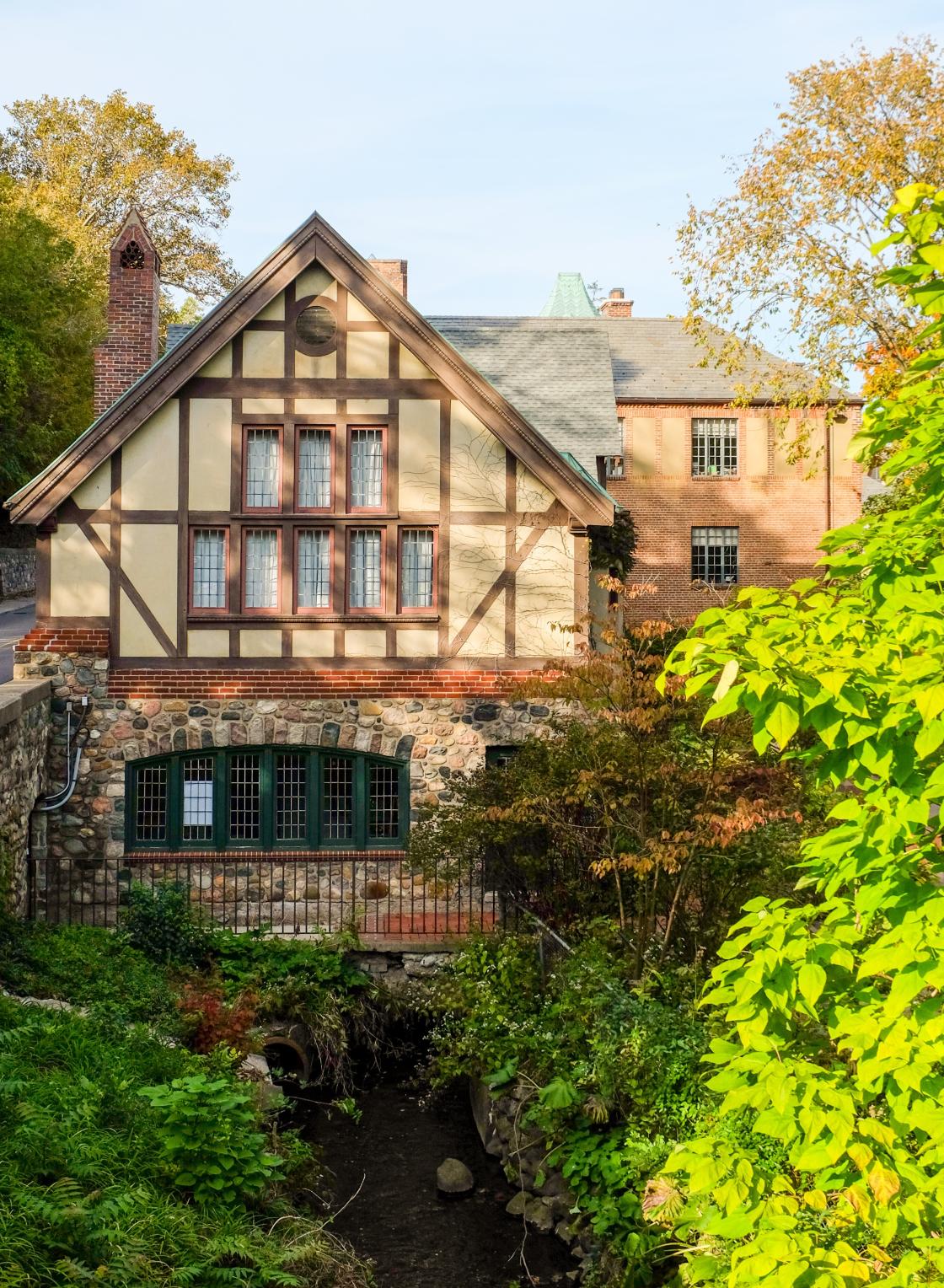
Join the Center as we open the doors to historic Brookside School Cranbrook for special art and architecture tours! Originally a school for the Booths’ grandchildren—and rarely opened for public tours—the campus is now the home of Cranbrook Schools’ Brookside Lower School and Vlasic Early Childhood Center. The care of Brookside’s rich collection of historic furnishings and works of art is entrusted to Cranbrook Center for Collections and Research. Led by the Center’s curators and educators, the tours will explore the picturesque architecture of the complex, including the historic Meeting House and the contemporary addition by world-renowned architect Peter Rose, Brookside’s collection of custom furnishings, and its unique works of art.
HIGHLIGHTS OF THE TOUR
Meeting House
The oldest academic building at Cranbrook, the Meeting House was designed by Cranbrook co-founder George Gough Booth and his son Henry Scripps Booth. A charming Arts & Crafts building, it was constructed in 1918 to be a center for social, instructional, political, and religious gatherings for the Booth family and growing Bloomfield community. Religious services began in the Meeting House in 1919, led by George Booth’s father, Henry Wood Booth, and Brookside School opened in the Meeting House in 1922.
Architectural Details
From the colorful Mother Goose carvings by Joachim Jungwirth along Cranbrook Road to Dan Hoffman’s Pickle Hut, a shingled tepee-shaped hut on an island in the adjacent Rouge River, and Gary Griffin and Peter Rose’s Bee Gates, Brookside’s grounds have been created to delight the eyes and capture the imagination of Cranbrook’s youngest learners.

The Art of Children’s Literature
Starting in the 1980s and continuing into the 2010s, Brookside School collected original artworks from children’s literature. Highlights, which will be displayed in Brookside’s library, include memorable illustrations from the pages of Imogene’s Antlers written and illustrated by David Small (a native Detroiter), Kenneth Grahame’s The Reluctant Dragon illustrated by Michael Hague, and many, many more.
Sculpture
The artwork in the school contributes to the aesthetic and historical richness of the Brookside campus. Many of these objects were created by artists associated with Cranbrook Academy of Art, Cranbrook Schools, or the Booth family. Highlights include Carl Milles’s Moose and Berthold “Tex” Schiwetz’s Jonah and the Fishbone Harp, which float above the children as they use the stairwells in the Vlasic Early Childhood Center, and the original carved stone tympanum, or architectural pediment, which Henry Scripps Booth rescued from the entrance of the Booth family’s first home in Detroit on Trumbull Avenue.
Decorative Tiles
Decorative ceramic tiles are used throughout the exterior and interior of Brookside as integral architectural decorations. Featuring works by artists and studios such as the Austrian designer Annie Eisenmenger and contemporary installations by Pewabic Pottery, these tiles represent a 100-year tradition of ceramic ornamentation at Brookside.
Stained Glass
Since the 1923 addition, stained glass has featured prominently in Brookside’s buildings. Five panels, created by British artist Alexander Kay Herbert, depict subjects studied in primary education: Dance, Drama, Geography, Mathematics, and Music. In addition, impressive windows with individual glass panels by Baxter Glass Art from the late 1980s to the present commemorate retired Brookside faculty and staff.
Archival Treasures
For this Behind-the-Scenes Tour, special documents from the Archives will be on display, including yearbooks, historic photographs, and Brookside memorabilia.
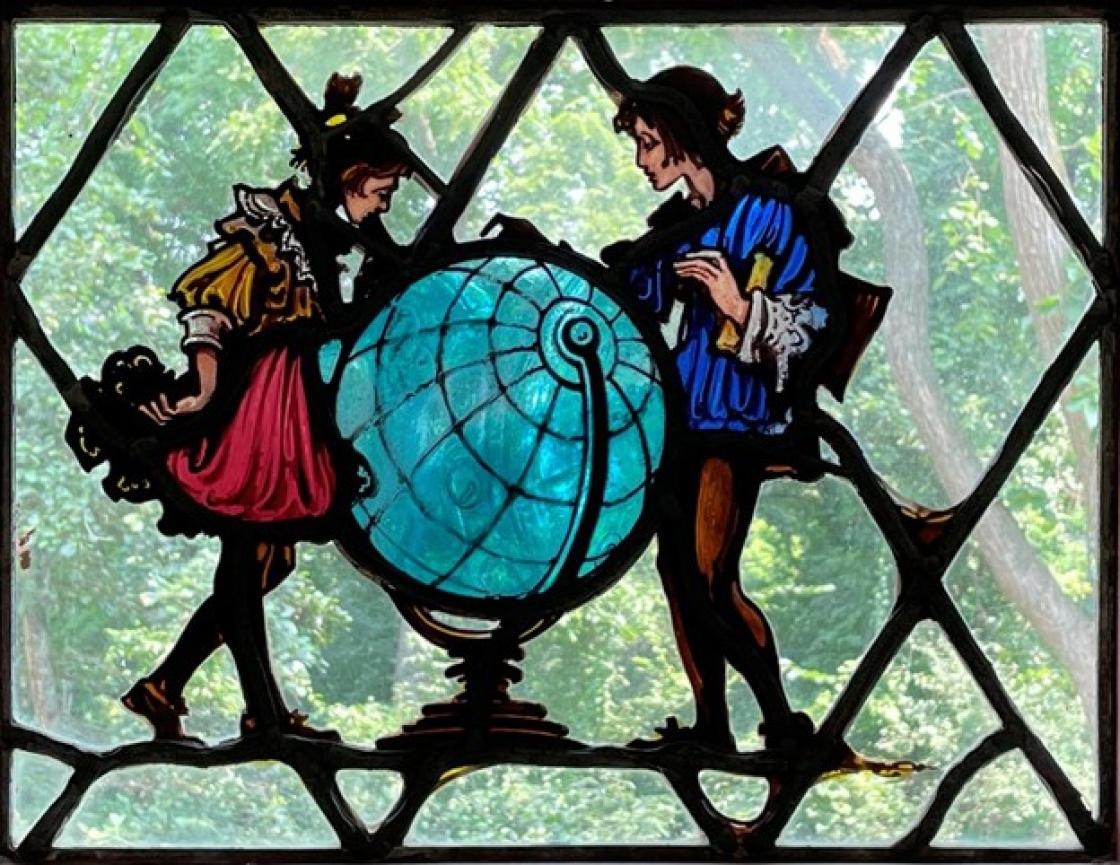
AN ARCHITECTURAL HISTORY OF BROOKSIDE SCHOOL
Cranbrook founders George Gough Booth and Ellen Scripps Booth began building the Meeting House in 1918 at the corner of Lone Pine and Cranbrook Roads. It was designed by George Booth and his son Henry Scripps Booth and incorporated excess construction materials from the recent expansion of Cranbrook House (the North Wing and Library addition also was built in 1918). In 1919, the new Meeting House opened as a site for religious instruction and served as a day school for the Booths’ grandchildren and the children of the Booths’ chauffeur and gardener.
Three years later, in September 1922, the Bloomfield Hills School opened in the Meeting House with Jessie T. Winter as the Head and teacher. Winter had seven pupils ranging in age from three to seven years of age.
During the summer of 1923, George Booth added a two-story fieldstone and half-timbered stucco addition, of his own design, onto the northern end of the Meeting House and had it delightfully decorated in an Arts & Crafts manner. He called upon Detroit sculptor Joachim Jungwirth to carve an elaborate Mother Goose oriel window and grape-patterned barge boards for the building and asked Katherine McEwen to paint the facade overlooking the Rouge River on the east side. He commissioned Detroit glass artist Alexander Kay Herbert to execute five stained glass panels for the addition depicting instruction in Dance, Drama, Geography, Mathematics, and Music. The section added eight new rooms to the school, including a second-floor apartment for Jessie Winter.
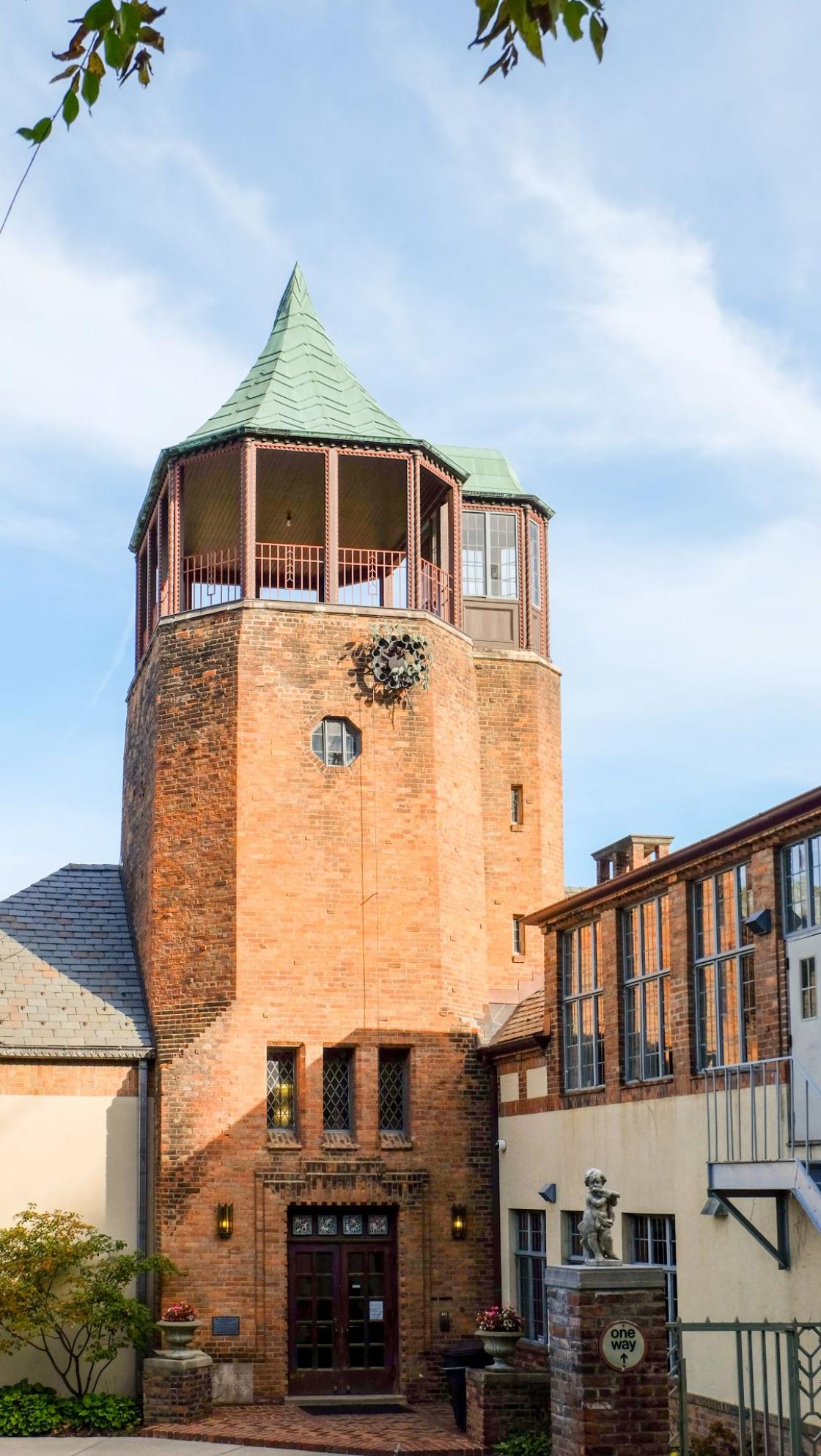
In the summer of 1924, George Booth added another section onto the building, a stone and stucco building built over water-driven hydraulic ram pumps in the basement—aptly named the Ram House. A pair of carved ram’s heads, originally commissioned by Booth in 1916 for the Flowing Well (now known as the Rainbow Fountain), were moved to adorn this new addition. It also boasted another elaborately carved barge board by Joachim Jungwirth.
The Booths’ greatest early contribution to the school, however, occurred on June 16, 1925, when George and Ellen Booth created a Children’s School Trust for the Bloomfield Hills School under the trusteeship of their sons and sons-in-law. The Booths transferred the title of the property to the trust, established an endowment of $100,000 to support school operations, and added a dining room to the school.
As the school’s popularity grew, enrollment soon overtaxed the facilities. To help the children’s school meet these new objectives and to allow for future growth, the Cranbrook Foundation, which was established in 1927, commissioned Henry Scripps Booth, who had studied architecture at the University of Michigan, to design a large fireproof building for it in 1929. With the dedication of the expanded school came a new name: Brookside. The name came from the school’s setting beside a branch of the Rouge River known as the Crane.
The most recent addition to Brookside Lower School came in 1996 when Cranbrook Schools opened the Vlasic Early Childhood Center, designed by Canadian architect Peter Rose. Vlasic Early Childhood Center, commonly called the ECC, is a dedicated facility designed specifically for the education and development of Cranbrook’s youngest learners: classes of pre-, junior-, and senior-kindergarten students.
Brookside Lower School continues to operate in these historical quarters as a co-educational school.
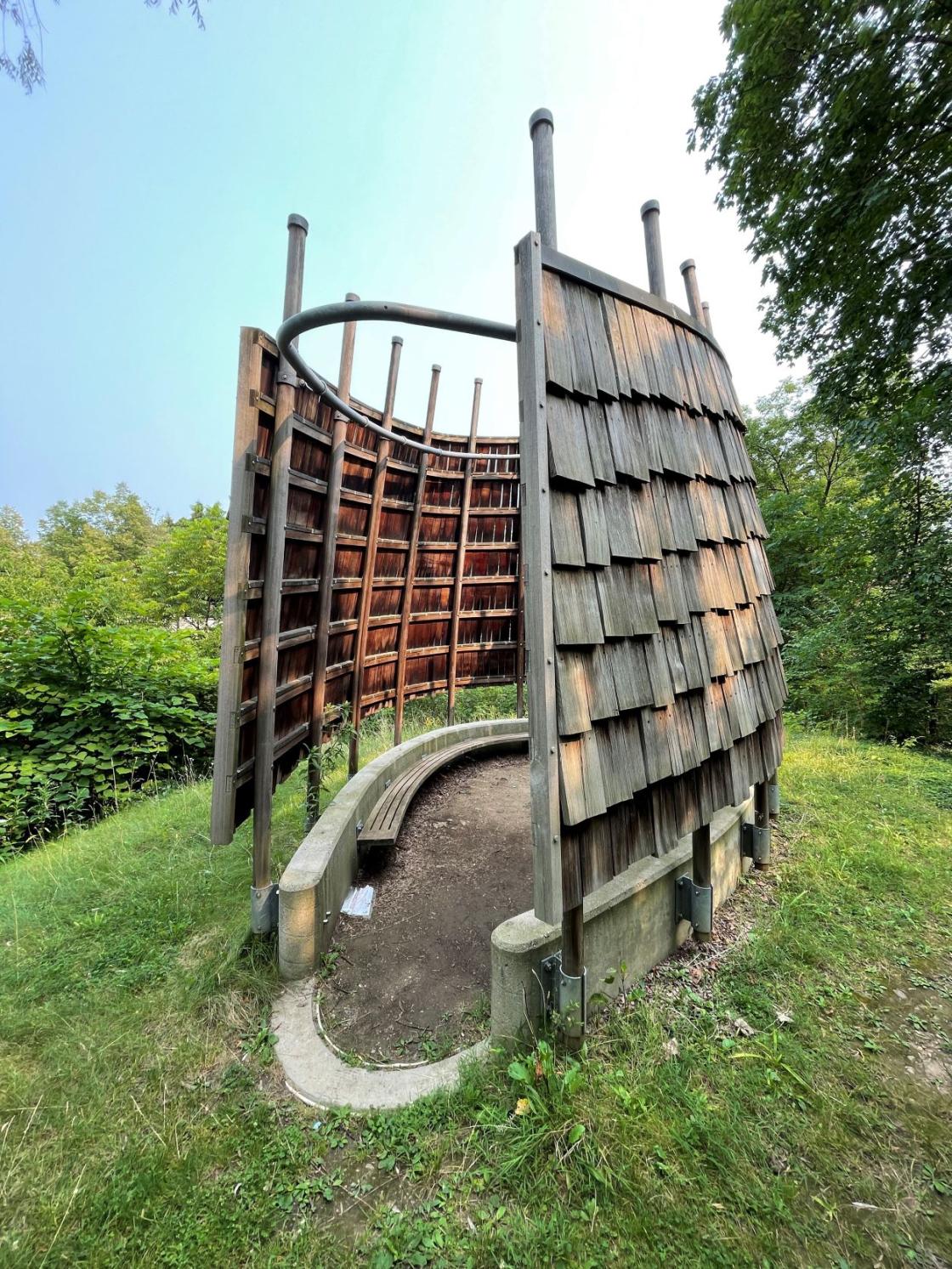
ABOUT YOUR TOUR LEADERS
Curator for Cranbrook Center for Collections and Research, Kevin Adkisson works on preservation, interpretation, and programming across the many buildings and treasures of Cranbrook. He presents a popular History of American Architecture Lecture Series each winter, and has curated a variety of exhibitions within Cranbrook House, Saarinen House, and the Frank Lloyd Wright-designed Smith House. A native of Marietta, Georgia, Adkisson holds a BA in Architecture from Yale and an MA from the University of Delaware’s Winterthur Program in American Material Culture, with a thesis examining the role of postmodernism in shopping mall architecture.
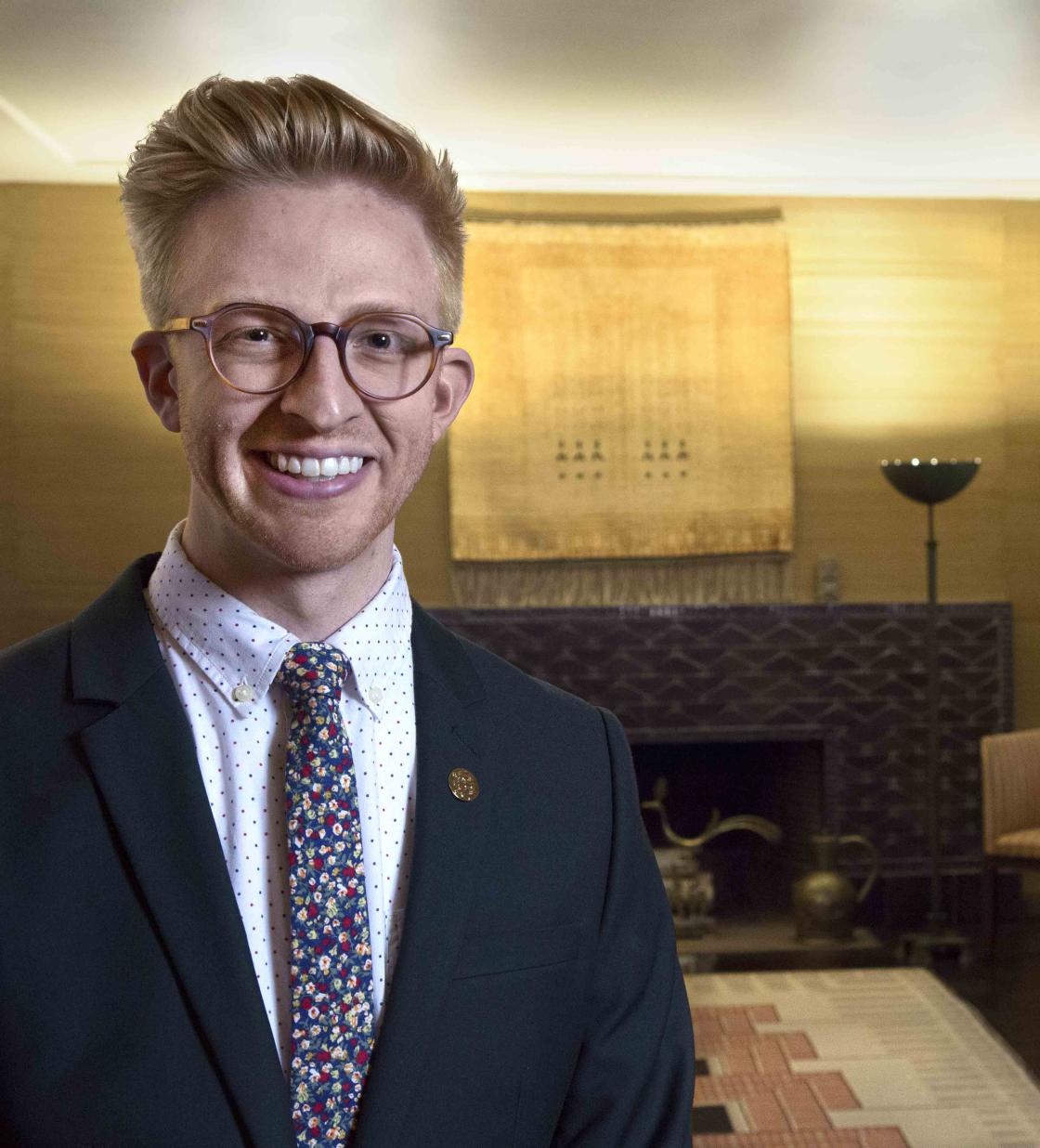
Nina Blomfield is the Center’s 2021-2023 Decorative Arts Trust Marie Zimmermann Collections Fellow. Nina received her BA from Victoria University of Wellington, New Zealand, and earned her MA in History of Art at Bryn Mawr College, Pennsylvania, where her thesis focused on the use of Japanese decorative arts by middle-class American women. She is currently completing a PhD at Bryn Mawr that examines the material culture of domestic space and the global origins of Victorian home decorating. Nina has worked at the National Library of New Zealand’s Alexander Turnbull Library and has held graduate internships in the American Wing of the Metropolitan Museum of Art and in Bryn Mawr College's Special Collections, where she curated the exhibition “All-Over Design”: Lockwood de Forest between Ahmedabad and Bryn Mawr.
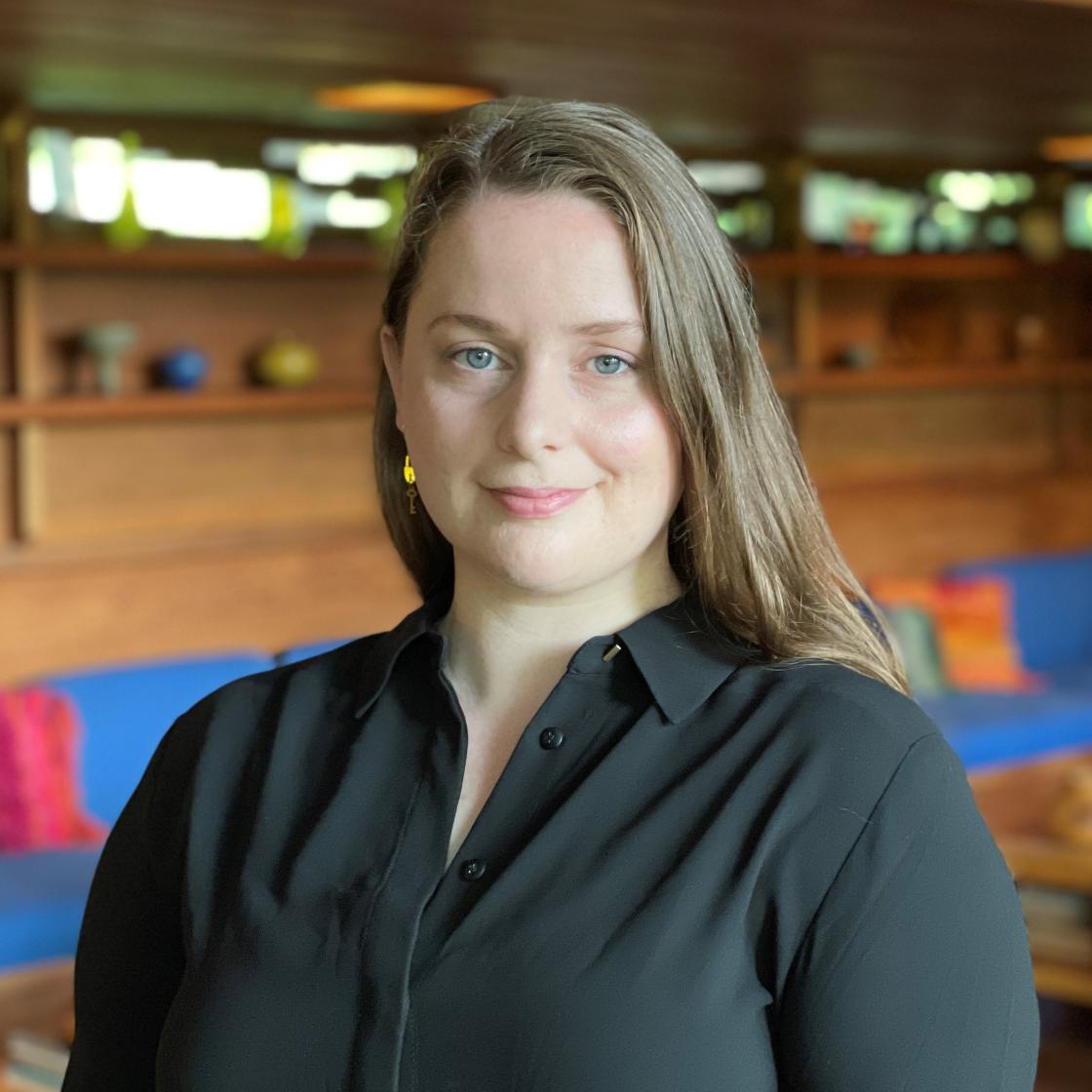
ADDITIONAL INFORMATION
PARKING AND ARRIVAL
Tours begin on the north end of the Brookside Lower School campus at the Vlasic Early Childhood Center (commonly called the ECC), located at 652 Cranbrook Road. Free parking is available in the parking lot on the north side of the ECC with additional parking across the street, on the west side of Cranbrook Road, in the gravel Brookside Overflow lot. Enter the Brookside Overflow parking lot through the iron gates, directly across the street from Thornlea (700 Cranbrook Road). Parking for cars with disability parking placards or license plates is available in the paved lot on the north side of the ECC.
Check-in will be at a clearly marked table at the entrance to the Vlasic Early Childhood Center. You do not need to print your receipt.
TOUR LENGTH
The tours are approximately 75 minutes in length and include stairs. Tours take place rain or shine.
PHOTOGRAPHY
Photography is permitted for personal use only. No special equipment or tripods may be brought on the tour. Brookside is an active school; photography of Cranbrook staff and students who may be present in the building is not permitted.
CHILDREN
For the safety and comfort of all visitors, children younger than eight years old, including infants and toddlers, are discouraged on this tour.
COATS AND BAGS
Only small wallets and handheld cameras are permitted on the tours. Please leave all backpacks, purses, camera bags, camera equipment, and other cumbersome items in vehicles.
REFUND POLICY
Tickets are non-refundable. Your ticket may be transferred to another participant for the tour on the same day and time as the original ticket.
SERVICE ANIMAL POLICY
Cranbrook Center for Collections and Research is glad to accommodate visitors accompanied by service animals, as defined by the Americans with Disabilities Act (ADA), on tours of Saarinen House, Smith House, and the Cranbrook campus, including Brookside School. Under the ADA, a “service animal” is defined as a dog that has been individually trained to do work or perform tasks for an individual with a disability. The task(s) performed by the dog must be directly related to the person's disability. Regretfully, we cannot accommodate visitors accompanied by emotional support animals or pets.
Visitors who will be accompanied by service animals are welcome to call the Center at 248-645-3307 in advance of their scheduled tour so that we may address any questions or concerns.
ACKNOWLEDGMENT OF RISK
An inherent risk of exposure to COVID-19 exists in any public place where people are present. COVID-19 is a contagious disease that can lead to severe illness and death. According to the Centers for Disease Control and Prevention, guests with underlying medical conditions are especially vulnerable. By visiting a Center-managed site, you voluntarily assume all risks related to COVID-19 exposure.
PHOTO CREDITS
Header image: Brookside School’s Meeting House and 1923 Addition, Photographed in 2019; Photography by Daniel Smith, CAA '21, Courtesy of Cranbrook Center for Collections and Research.
Brookside Meeting House, Photographed in 2021; Photography by Daniel Smith, CAA '21, Courtesy of Cranbrook Center for Collections and Research.
Brookside School’s Main Entrance Lobby Featuring a Light Fixture Designed by Henry Scripps Booth and the 50th Anniversary Rug, Photographed in 2019; Photography by Daniel Smith, CAA '21, Courtesy of Cranbrook Center for Collections and Research.
"Geography" Stained Glass Window, 1923, Alexander Kay Herbert (Artist). Cultural Properties Collection, Cranbrook Kingswood Lower School Brookside; Photography by Leslie Mio, Courtesy of Cranbrook Center for Collections and Research.
Brookside School’s Tower, the focal point of the 1929 addition to the school, Photographed in 2019; Photography by Daniel Smith, CAA '21, Courtesy of Cranbrook Center for Collections and Research.
Pickle Hut, 1997, Dan Hoffman for Cranbrook Architectural Office (Designer). Cultural Properties Collection, Cranbrook Kingswood Lower School Brookside. Photography by Kevin Adkisson, Courtesy of Cranbrook Center for Collections and Research.
Kevin Adkisson in Saarinen House, 2017; Photography by P.D. Rearick, CAA '10, Courtesy of Cranbrook Center for Collections and Research.
Nina Blomfield in Smith House, 2021; Photography by Kevin Adkisson, Courtesy of Cranbrook Center for Collections and Research.
